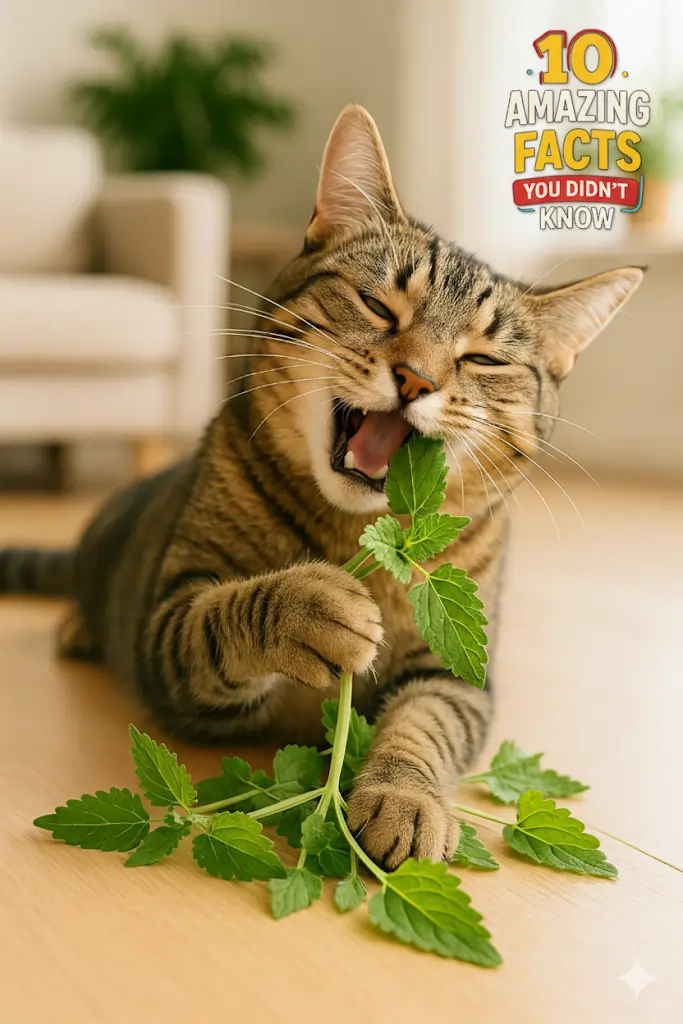The Surprising Benefits of Catnip for Your Feline Friend!
If you’ve ever sprinkled a little catnip on the floor and watched your cat roll around in sheer bliss, you’ve seen the magic firsthand. But here’s the big question: is catnip just a fun treat, or does it offer real benefits for your feline friend?
At 10AmazingFactsUDidntKnow.com, we love diving into the hidden truths that make the everyday world more fascinating. Today, we’re exploring the surprising science, health benefits, and even the myths around catnip. By the end of this article, you’ll see why catnip deserves a permanent spot in your cat’s toy box—and why subscribing to our site unlocks even more insights like this to keep your pets happy and healthy.
What Exactly Is Catnip?
Catnip, scientifically known as Nepeta cataria, is a member of the mint family. Its active ingredient, nepetalactone, is what sparks the strange but delightful reactions in cats. This compound binds to receptors in a cat’s nose, triggering a burst of playful, euphoric behavior.
Not every cat responds, though. Studies show that about 50–70% of cats are sensitive to catnip, and genetics play a major role. If your feline friend is one of the lucky responders, catnip can be more than entertainment—it can be a wellness tool.
The Surprising Benefits of Catnip for Cats
Let’s break down the key catnip benefits for cats that go beyond fun and games.
1. Stress Relief and Relaxation
Cats can experience anxiety just like humans. Changes in environment, loud noises, or even separation can stress them out. Catnip has natural calming effects that help reduce anxiety, almost like aromatherapy for cats.
Veterinarians often recommend catnip for stress relief in cats during events like moving homes or introducing a new pet. A few sprinkles can make a huge difference.
2. Encourages Healthy Exercise
If your cat is a little on the “fluffy” side, catnip can be a lifesaver. By stimulating their playful instincts, catnip gets them jumping, running, and pouncing—turning lazy afternoons into active play sessions.
Think of it as a natural catnip and exercise booster: better playtime, better fitness.
3. Mental Stimulation and Enrichment
Indoor cats can get bored easily. Without the thrill of outdoor hunting, they may become restless or even destructive. Catnip acts as a stimulation tool, giving cats mental engagement that keeps their brains sharp.
When used with catnip toys, your cat’s play transforms into meaningful enrichment that satisfies their instincts.
4. A Safer Alternative to Medication
While there are medications for feline anxiety and boredom, they often come with side effects. Catnip provides a natural, organic solution. For many owners, organic catnip for cats is a simple, affordable, and safe way to improve their pet’s well-being.
Is Catnip Safe for Cats?
One of the most common questions is: is catnip safe for cats?
The short answer: yes.
Catnip is non-addictive and safe when used in moderation. Some cats may overindulge and vomit or have mild digestive upset, but this is rare. Most veterinarians agree that catnip can be part of a healthy, balanced pet lifestyle.
For the best results, stick to natural catnip for cats and avoid cheap fillers. Organic options ensure purity and safety.
Why Do Cats Love Catnip So Much?
The reactions—rolling, rubbing, purring, or even “zoomies”—may look like pure silliness, but there’s science behind it. Nepetalactone triggers a response in a cat’s olfactory system (their sense of smell). This creates sensations similar to feline pheromones, which is why cats appear so blissfully entranced.
Interestingly, cats respond differently: some get hyperactive, others mellow out. That’s why catnip is often called a “mood enhancer” for felines.
How to Use Catnip for Your Cat
Catnip is versatile. You can use it in multiple ways depending on your cat’s needs:
-
Catnip toys: Encourage play and exercise.
-
Loose catnip: Sprinkle on scratching posts or bedding for relaxation.
-
Catnip sprays: Quick and easy option for furniture training.
-
Catnip-infused treats: A tasty way to deliver health benefits.
The key is to rotate usage so your cat doesn’t build up a tolerance. Experts suggest offering catnip once or twice a week for the best effects.
Counterarguments: Does Catnip Work for Every Cat?
Not all cats react. Some are genetically immune, especially kittens under 6 months. If your cat doesn’t respond, it doesn’t mean something’s wrong—it just means catnip isn’t in their DNA.
In these cases, alternatives like silvervine or valerian root can provide similar stimulation.
The Future of Catnip: Beyond Playtime
Researchers are exploring catnip for more than feline fun. A recent study in Science Advances suggested that nepetalactone might even repel mosquitoes. Imagine catnip not only entertaining your pet but also protecting your home environment.
This dual use makes catnip one of the most exciting natural remedies for both pets and people.
Why You Should Subscribe to 10AmazingFactsUDidntKnow.com
Here at 10AmazingFactsUDidntKnow.com, we don’t just give you surface-level trivia—we dive into the hidden science and surprising facts that keep you curious.
By subscribing today, you’ll unlock:
-
Exclusive deep-dive articles like this one.
-
Behind-the-scenes videos that reveal fascinating facts.
-
Unlimited access to content designed to entertain and educate.
-
A chance to join a community of curious minds.
And don’t forget—subscribe to our YouTube channel for visual fact journeys that bring our stories to life.
👉 Don’t just read—be part of the journey. Subscribe now and support the content you love.

FAQs About Catnip and Cats
1. What is catnip made of?
Catnip contains the compound nepetalactone, which triggers sensory receptors in cats.
2. Can kittens use catnip?
Most kittens under 6 months don’t respond to catnip. Their sensitivity develops with age.
3. How often should I give my cat catnip?
Limit to 1–2 times a week to avoid reduced sensitivity.
4. Is catnip safe for older cats?
Yes, senior cats often benefit from the stimulation and relaxation catnip provides.
5. Can catnip help with cat training?
Absolutely. Sprinkling catnip on scratching posts can redirect destructive scratching.
6. Does catnip work on all cats?
No, about 30–50% of cats are non-responders due to genetics.
7. Can too much catnip harm my cat?
Excessive ingestion may cause mild stomach upset, but it’s generally harmless.
8. What’s the difference between fresh and dried catnip?
Fresh catnip has stronger oils, but dried catnip is more convenient and long-lasting.
9. Is organic catnip better?
Yes, organic catnip avoids pesticides and harmful chemicals.
10. Does catnip affect humans?
Not in the same way—it has mild calming properties in teas but won’t cause feline-like reactions.
Final Thoughts
The surprising benefits of catnip for your feline friend go far beyond entertainment. From stress relief to exercise and mental enrichment, catnip is a safe, natural way to improve your cat’s quality of life.
If you enjoyed this breakdown, imagine what else you could discover by becoming a subscriber at 10AmazingFactsUDidntKnow.com. Don’t stop at one amazing fact—unlock a whole world of them.
👉 Subscribe today, support our work, and keep the curiosity alive—for you, your pets, and beyond.
